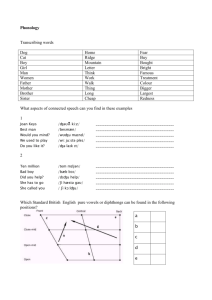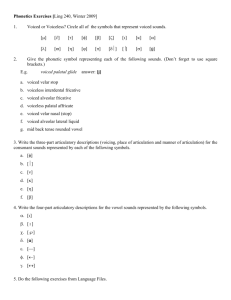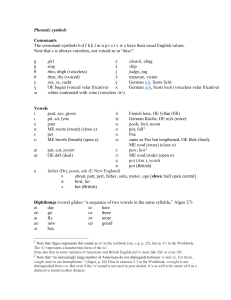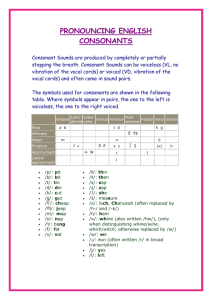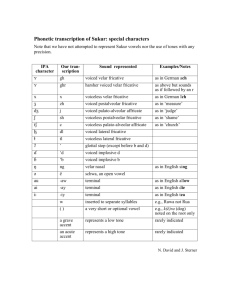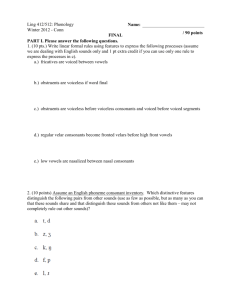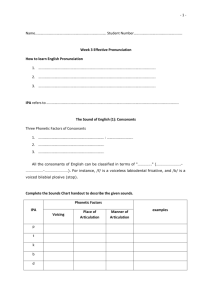here - OpenCUNY!
advertisement
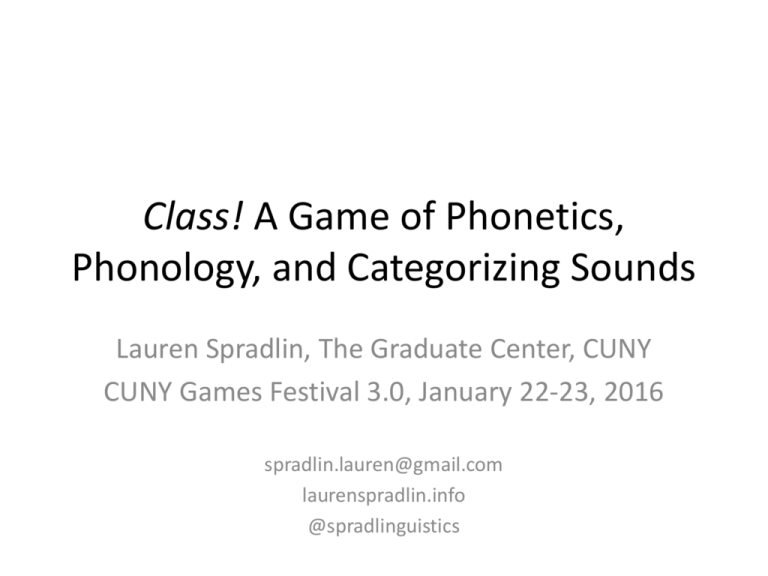
Class! A Game of Phonetics,
Phonology, and Categorizing Sounds
Lauren Spradlin, The Graduate Center, CUNY
CUNY Games Festival 3.0, January 22-23, 2016
spradlin.lauren@gmail.com
laurenspradlin.info
@spradlinguistics
Roadmap
• Introduction
• Background
– SET
– Linguistics
– Phonology
• Class!
–
–
–
–
Instructions
Deck
We’ll play
Alternate ways to play
2
Background
• SET, The Family Game of
Visual Perception
– designed by Geneticist Marsha
Falco in 1974
– originally published in 1991
– won American Mensa’s
Mensa Select Award in
1991
3
How to play
• Who’s already familiar with
SET?
• The deck consists of 81 unique
cards specified for four
features:
–
–
–
–
color (red, green, purple)
shape (diamond, oval, squiggle)
shading (solid, shaded, empty)
number (one, two, or three
shapes per card)
4
How to play
• A set consists of three cards
which, with regard to each
feature, are all the same or
all different
• Alternatively, if a group
contains two of ___ and one
of ___, it isn’t a set
5
6
7
8
9
10
11
12
13
14
15
16
17
What’s Linguistics?
• Linguistics is a field of study concerned with
Language as a phenomenon
– human language is our object of study
• Linguists aim to accurately and elegantly
describe systematic linguistic processes
– kinesiologists : walking :: linguists : language
• Phonetics and Phonology are subfields
dedicated to sounds
18
#linguistproblems
Phonetics
• How sounds are
physically produced and
perceived
– articulatorily
– acoustically
• How do you make an s
sound?
• How about m? l?
• What are the acoustic
properties of these
sounds?
Phonology
• How sounds are
categorized by speakers
– which sounds belong to a
language
– how sound systems are
organized
– breaking the speech
stream into words
– how sounds behave
around each other (plurals)
– which sounds can and
cannot co-occur
(psychology, caps)
19
English spelling is problematic
•
•
•
•
•
•
•
•
•
•
Colonel
Sixth
Would, wood
Anemone
Squirrel
Tenacious, tenacity
Onomatopoeia
Otorhinolaryngologist
c, g, j, l, m, t, y
double consonants,
silent <e>
• Terminology:
–
–
–
–
sound
letter
consonant
vowel
• How might we
circumvent its spelling
eccentricities?
20
Grab your handout
• The International Phonetic Alphabet
– a transcription tool used by linguists to ensure a
one-to-one correspondence between symbol and
sound
– spelling bees, ghoti (tough, women, nation)
– You have an English subset on one side, and the
whole IPA on the back
21
The IPA: Consonants of English
22
23
IPA organization
• A symbol’s place of
articulation is given in
the columns
• bilabial, labiodental, etc.
• Its manner of
articulation is given in
the rows
– nasal, plosive, fricative,
etc.
• These will act as your
colors and squiggles
24
You, phonology, and t
• Do all these words
have t sounds in
them?
•
•
•
•
•
•
•
•
Tucson
butter
stop
cat
tree
mountain
prints, prince
center
• Yes and no
• Phonetically they have [tʰ]
[ɾ], [t], [t ̚], [ʧ], [ʔ], [ʦ]?,
and Ø, respectively
• English speakers group
these sounds into a
category they recognize
as /t/
• Any Spanish speakers
here?
25
You and phonology at the zoo
• How do we pluralize in
English?
• How do you pronounce
the plural of these
animals?
–
–
–
–
–
–
chimp
meerkat
yak
lamb
leopard
warthog
• “Add an –s” turns out to
mean two phonetic
sounds
• [s] and [z]
–
–
–
–
–
–
chimp
meerkat
yak
lamb
leopard
warthog
26
You and phonology at the zoo
• Any ideas why?
• The voicing of the final
sound
–
–
–
–
–
–
chimp
meerkat
yak
lamb
leopard
warthog
• A similar process
happens with English
past tense:
–
–
–
–
stopped
stalked
robbed
hugged
27
Voicing assimilation
• Both the English plural and past tense
undergo ‘voicing assimilation’ meaning that
they match the final sound in the word they
attach to in voicing status
28
Natural classes
• A natural class is “a group of sounds that
includes all the relevant sounds [participating
in a pattern] to the exclusion of all other
sounds in a language”
• Returning to the zoo, we see that voiceless
plosives are pluralized with -[s] and voiced
plosives get -[z]
– plosives are a natural class: [p, t, k, b, d, g]
– voiceless and voiced plosives are more restrictive
ones: [p, t, k] and [b, d, g]
29
Natural classes
• Place of Articulation
– along the top of your chart, place of articulation
can matter too
– Did anyone notice I glossed over walruses and
horses and presented and applauded?
– These plurals get –[ɪz] because they match –/z/ in
place and manner, and the verbs get –[ɪd] because
they match –/d/ in place and manner
30
An aside on natural classes and features
• In more advanced phonological situations,
phonemes are often described in terms of binary
features bundled together
– map [mæp] currently
– using distinctive features (Hayes 2009: 71)
31
05184120_4_C04.qxd
06/06/2008 09:50 AM Page 95
9781405184120_4_C04.qxd
06/06/2008 09:50 AM Page 96
9781405184120_4_C04.qxd
06/06/2008 09:50 AM Page 97
All the features (of consonants)
Features
Place features
Laryngeal
M anner features
+
+
+
+
+
+
+
+
+
+
+
-
-
+
+
+
+
+
-
+
+
+
+
+
+
+
+
+
+
+
+
+
+
+
+
+
+
+
+
+
+
+
0
0
0
0
0
0
0
0
0
0
0
+
+
+
+
+
+
+
+
+
+
+
+
+
+
+
+
+
+
-
0
0
0
0
0
0
0
0
0
0
0
+
+
+
+
+
+
+
+
+
0
0
0
0
0
0
0
0
0
0
0
+
+
+
+
+
+
+
+
-
+
+
+
+
+
-
-
0
0
0
0
0
0
0
0
0
0
0
0
0
0
0
0
0
0
0
0
0
0
0
0
0
0
0
0
0
0
0
0
0
0
0
0
0
0
0
0
0
0
0
0
0
0
0
0
0
0
0
0
0
0
0
0
0
0
0
0
0
0
0
0
0
0
0
0
0
0
0
0
0
0
0
0
0
0
0
0
0
0
0
0
0
0
0
0
0
0
0
0
0
0
0
0
0
0
0
0
0
0
0
0
0
0
0
0
0
0
0
0
0
0
0
0
0
0
0
0
0
0
0
0
0
0
0
0
0
0
0
0
0
0
0
0
0
0
0
0
0
0
0
0
0
0
0
0
0
0
0
0
0
0
0
0
0
0
0
0
0
0
0
0
0
0
0
0
0
0
¡
≥
Ë
Ô
‹
⁄
ø
æ
1
g
ß
xß
j
k
g
º
5
x
“
Å
kj
g
j
xj
“j
q
{
ç
¿
É
á
∑
˜
ˆ
h
∂
+
+
+
+
+
+
+
+
+
+
+
+
+
+
+
+
+
+
+
+
+
+
+
+
+
+
+
+
+
+
+
-
+
+
+
+
+
+
+
+
+
-
+
+
+
+
+
+
+
+
+
+
+
+
+
+
+
+
+
+
+
+
+
0
0
0
0
+
0
0
+
+
+
0
+
+
+
+
0
0
+
+
+
+
+
+
+
+
+
-
+
-
+
-
+
+
+
-
+
+
+
+
+
+
+
+
+
+
+
+
+
+
+
+
+
+
+
+
+
+
+
-
-
-
-
+
+
+
+
+
+
+
+
-
0
0
0
0
0
0
0
0
0
0
0
0
0
0
0
0
0
0
0
0
0
0
0
0
0
0
0
0
0
0
0
0
0
0
0
0
0
0
0
0
0
0
0
0
0
0
0
0
0
0
0
0
+
+
0
0
0
0
0
0
0
0
0
0
0
0
0
0
0
0
0
0
0
0
0
0
0
0
0
0
+
+
+
-
+
+
+
+
+
+
+
+
+
+
+
+
+
+
+
+
+
+
+
+
+
+
+
-
0
0
0
0
0
0
0
0
+
+
+
+
+
+
+
+
+
+
+
+
+
+
+
0
0
0
0
0
0
0
0
0
0
0
+
+
0
0
0
0
0
0
0
0
0
0
0
+
+
+
+
0
0
0
0
0
0
0
0
0
0
0
0
0
0
0
0
0
0
0
0
0
0
0
0
0
+
+
+
+
+
+
+
+
+
+
+
+
0
0
0
0
0
0
0
0
0
0
0
0
0
0
+
0
0
0
0
0
0
0
0
0
0
0
0
0
0
0
0
0
0
0
0
0
0
alveolopalatal labial- labial- labialfront velar back
velar
velar
-
retroflex
-
fronted velar
+
+
+
+
+
+
+
+
+
+
+
+
+
+
+
+
+
+
+
+
+
velar
+
+
+
-
back velar
+
+
-
uvular
+
+
-
pharyn
+
+
+
+
+
+
+
glottal
bilabial
labiodental
dental
alveolar
palato-alveolar
+
+
0
0
+
+
+
0
0
+
+
+
+
+
+
+
0
0
+
+
0
0
0
+
+
+
+
0
tense
back
front
low
high
dorsal
lateral
strident
distributed
anterior
coronal
labiodental
round
labial
constr gl
spread gl
voice
nasal
trill
tap
approximant
delayed release
continuant
sonorant
consonantal
+
+
+
+
+
+
+
+
+
+
+
+
+
+
+
+
+
+
+
Place features
Laryngeal
features
tense
back
front
low
high
dorsal
lateral
strident
distributed
anterior
coronal
labiodental
round
labial
constr gl
spread gl
voice
nasal
trill
tap
approximant
delayed release
continuant
sonorant
consonantal
+
+
+
+
+
+
+
+
+
+
M anner features
Place features
Laryngeal
features
tense
back
front
low
high
dorsal
lateral
strident
distributed
anterior
coronal
labiodental
round
labial
constr gl
spread gl
voice
nasal
trill
tap
approximant
delayed release
continuant
sonorant
consonantal
+
+
+
+
+
+
+
+
+
+
+
+
+
+
+
+
+
+
+
+
+
+
+
+
+
+
+
+
+
+
+
+
-
97
T able 4.8 Consonants II: complex segments
features
p
b
z
b
m
x
4
f
v
ª
ã
to
do
â
¨
t
d
3
2
t»π
s
z
n
l
π
∫
Ü
å
r
\
]
à
è
Á
Features
T able 4.7 (cont ’d)
Consonants I: single place of articulation
M anner features
Features
palatal
T able 4.7
9596
w
Ï
Î
Á
+
+
+
-
+
+
-
0
+
-
+
-
-
-
-
+
+
+
-
-
+
+
+
+
+
+
-
-
-
0
0
0
0
0
0
0
0
0
0
0
0
-
+
+
+
+
+
+
+
+
-
0
0
+
+
0
0
+
+
0
0
’
Ë
Ô
≤
∆
c
~
ç
ÿ
¢
Ó
+
+
+
+
+
+
+
+
+
+
+
+
+
+
+
+
+
+
+
0
+
+
+
+
+
+
0
0
+
+
-
-
+
-
+
+
+
+
+
+
+
-
-
+
-
+
-
-
+
+
+
+
+
+
+
+
+
+
0
+
+
+
+
-
0
+
+
+
+
+
+
+
+
+
+
0
+
+
+
+
-
+
+
+
+
+
+
+
+
+
+
+
+
+
+
+
+
+
+
+
+
+
+
+
-
+
+
+
+
+
+
+
+
+
+
+
-
+
0
0
0
0
0
0
0
0
0
0
(Hayes 2009: 95-97)
features deduced by looking up a similar sound and changing the most obvious
features; or you can try using the FeaturePad software listed in the Preface to this
book. A more complete feature chart can be downloaded as a spreadsheet from
www.linguistics.ucla.edu/people/hayes/120a/index.htm#features.
4.10.1
Consonants I: single place of articulation
For consonants that have two places of articulation (complex segments), see the next
section. All consonants are [-syllabic], and this feature is not included in the chart.
4.10.2
Consonants II: complex segments
These segments have two places of articulation. They are all [-syllabic], so this
feature is not included in the chart.
32
M anner features
Place features
Laryngeal
features
dental
labiodental
bilabial
tense
back
front
low
high
dorsal
lateral
strident
distributed
anterior
coronal
labiodental
round
labial
constr gl
spread gl
voice
nasal
trill
tap
approximant
delayed release
continuant
sonorant
consonantal
p
b
z
b
m
x
4
f
v
ª
ã
to
do
â
¨
t
d
3
+
+
+
+
+
+
+
+
+
+
+
+
+
+
+
+
+
+
+
+
+
-
+
+
+
+
+
+
+
+
-
+
+
0
0
+
+
+
0
0
+
+
+
+
+
-
-
+
-
+
+
-
+
+
+
+
+
+
+
+
+
+
-
-
-
+
+
+
+
+
+
+
+
+
+
+
-
-
+
+
+
+
+
-
+
+
+
+
+
+
+
0
0
0
0
0
0
0
0
0
0
0
+
+
+
+
+
+
+
0
0
0
0
0
0
0
0
0
0
0
+
+
+
+
-
0
0
0
0
0
0
0
0
0
0
0
+
-
-
0
0
0
0
0
0
0
0
0
0
0
0
0
0
0
0
0
0
0
0
0
0
0
0
0
0
0
0
0
0
0
0
0
0
0
0
0
0
0
0
0
0
0
0
0
0
0
0
0
0
0
0
0
0
0
0
0
0
0
0
0
0
0
0
0
0
0
0
0
0
0
0
0
0
0
0
0
0
0
0
0
0
0
0
0
0
0
0
0
0
33
We’ll stick to descriptors on the chart
34
Class!
• A few years ago, I realized phonology is
basically a (messier) real-world game of SET
• Class! is SET with the symbols of the IPA
• For our purposes, the relevant features are:
– place of articulation (across the top of the chart)
– manner of articulation (down the side)
– voicing (voiceless and voiced, indicated by gray)
35
Class!
• The basic rules are similar:
– As quickly as you can, identify a set (natural class)
of at least three cards which share the same
specifications for place, manner, and voicing
– But, the class you choose must meet the
definition of natural class, and crucially include all
the relevant sounds to the exclusion of all others
(in play)
– The game is over when the deck is exhausted and
no possible natural classes remain
– The player with the most natural classes wins
36
ess
ar
al
ed
lar
p
ed)
al
l
ess
voiced
bilabial
stop
p
t ɹɹ d ll
ʔ
m
ʧ
ʤ
d ʧ ʤ
(voiced)voiceless (voiced)
bilabial bilabial (voiced)
palatal
(voiced)
glide stop palatal
glide
bilabial
glide
glide
b
(voiced)
lateral
(voiced)
approximant
lateral
approximant
(voiced)
central
(voiced)
approximant
central
approximant
voiced high voiceless high
voiced
voiceless
front
front
high voiced
high voiceless
voiceless
velar
velar
alveopalatal
alveopalatal
voiced
voiceless
tense
lax
front
front
alveolar
bilabial
bilabialalveopalatal
stop
stop
voiced
voiceless
affricate voicedalveopalatal
affricatevoiceless
unround
unround
tense alveolar
lax alveolar
stop
stop
stop affricatebilabial affricatebilabial
unround stop unround stop
stop
stop
k
g
bd t
n
ŋ
oʊ
h
u
ʊ
g
ʔ
m
u
ʊ
m ɹ l j w
high
high
(voiced) mid (voiced) mid
back
back
mid alveolar
mid voiceless back
high
high
voiced back
velar
glottal back
lax (voiced)
tense
lax voiced (voiced)
tense
back velar (voiced)
back
back voiceless (v
velar
nasal
nasal
stop
round
round
round
round
lax bilabial
tense glottal
lax velar palatal
tense velar l
stop
stop bilabial
round nasal round stop
round
round
glide stop
glide stop appr
mid
mid
low
mid
37
voiced
voiceless
central
central
mid
mid
o
o
pWhy thebborders?
t
• The IPA uses the same
grapheme oriented
differently to symbolize
different sounds
–ɹ~r
–ʍ~w
–ə~e
–ɐ~a
–ɔ~c
–m~ɯ
k
p
n
k
ʃn
d
g
ʔ
m
b t d
ŋg oʊ
h
ɯ
ʔ m
ʒŋ oʊ
s hz
voiced
alveolar
stop
v
a
(voiced)
voiced
bilabial
alveolar
nasal
stop
v
a
voiceless
high
(voiced)
glottal
back
bilabial
fricative
unround
nasal
tense
vowel
voiced
voiceless
alveolar
glottal
fricative
fricative
38
v
a
f
Let’s play!
m
t
s
d
h
ŋ
z
w
p
k
ʃ
n
39
Let’s play!
g
m
d
n
k
ŋ
p
t
h
w
ʔ
b
40
Let’s play!
l
ð
g
d
ŋ
v
ʔ
f
j
θ
b
ɹ
41
Other ways to play
• With the whole IPA, including vowels and
consonants
• With the phonemic inventory of a single language
• Only consonants or only vowels
• Using distinctive features
• With natural classes as encounter cards and
phonemes as ability cards
• Like poker or rummy, where whoever has the
most restrictive natural class wins
42
Other uses for the cards
• Flash cards
• Transcription practice
• In an ESL context, they could be modified to
teach sound-to-letter correspondences that
differ from the L1
43
[θæ̃ŋks]!
• Reference:
– Hayes, B. (2011). Introductory phonology (Vol.
32). John Wiley & Sons.
• Image credits:
–
–
–
–
Slide 2: Google Maps
Slide 3: SET Enterprises
Slide 6: mathmunch.org
Slide 7: @mrgteacher
44
